Brick
[3] Block is a similar term referring to a rectangular building unit composed of clay or concrete, but is usually larger than a brick.The oldest discovered bricks, originally made from shaped mud and dating before 7500 BC, were found at Tell Aswad, in the upper Tigris region and in southeast Anatolia close to Diyarbakir.As the Indus civilization began its decline at the start of the second millennium BC, Harappans migrated east, spreading their knowledge of brickmaking technology.[7] The earliest fired bricks appeared in Neolithic China around 4400 BC at Chengtoushan, a walled settlement of the Daxi culture.[15] According to Lukas Nickel, the use of ceramic pieces for protecting and decorating floors and walls dates back at various cultural sites to 3000-2000 BC and perhaps even before, but these elements should be rather qualified as tiles.For the longest time builders relied on wood, mud and rammed earth, while fired brick and mudbrick played no structural role in architecture.Hollow brick tomb chambers rose in popularity as builders were forced to adapt due to a lack of readily available wood or stone.The carpenter's manual Yingzao Fashi, published in 1103 at the time of the Song dynasty described the brick making process and glazing techniques then in use.Using the 17th-century encyclopaedic text Tiangong Kaiwu, historian Timothy Brook outlined the brick production process of Ming dynasty China: ...the kilnmaster had to make sure that the temperature inside the kiln stayed at a level that caused the clay to shimmer with the colour of molten gold or silver.Identifiable attributes included a low-pitched hipped or flat roof, symmetrical facade, round arch entrances and windows, columns and pilasters, and more.It was at this time in London that bright red brick was chosen for construction to make the buildings more visible in the heavy fog and to help prevent traffic accidents.[27] The transition from the traditional method of production known as hand-moulding to a mechanised form of mass-production slowly took place during the first half of the nineteenth century.[29] Henry Clayton, employed at the Atlas Works in Middlesex, England, in 1855, patented a brick-making machine that was capable of producing up to 25,000 bricks daily with minimal supervision.[30] His mechanical apparatus soon achieved widespread attention after it was adopted for use by the South Eastern Railway Company for brick-making at their factory near Folkestone.[32] The demand for high office building construction at the turn of the 20th century led to a much greater use of cast and wrought iron, and later, steel and concrete.[33] Following pioneering work in the 1950s at the Swiss Federal Institute of Technology and the Building Research Establishment in Watford, UK, the use of improved masonry for the construction of tall structures up to 18 storeys high was made viable.Unfired bricks, also known as mudbrick, are made from a mixture of silt, clay, sand and other earth materials like gravel and stone, combined with tempers and binding agents such as chopped straw, grasses, tree bark, or dung.[35][36] Since these bricks are made up of natural materials and only require heat from the Sun to bake, mudbricks have a relatively low embodied energy and carbon footprint.[38] However, additional clay could be added to reduce the need for straw, which would prevent the likelihood of insects deteriorating the organic material of the bricks, subsequently weakening the structure.Typically, longer drying times are preferred, but the average is eight to nine days spanning from initial stages to its application in structures.They are the product of thousands of years of decomposition and erosion of rocks, such as pegmatite and granite, leading to a material that has properties of being highly chemically stable and inert.The materials are mixed and left until the lime is completely hydrated; the mixture is then pressed into moulds and cured in an autoclave for three to fourteen hours to speed the chemical hardening.They are made from a dry, small aggregate concrete which is formed in steel moulds by vibration and compaction in either an "egglayer" or static machine.Some brickmakers create innovative sizes and shapes for bricks used for plastering (and therefore not visible on the inside of the building) where their inherent mechanical properties are more important than their visual ones.The introduction of asphalt and concrete reduced the use of brick for paving, but they are still sometimes installed as a method of traffic calming or as a decorative surface in pedestrian precincts.[50] Much like in Grand Rapids, municipalities across the United States began replacing brick streets with inexpensive asphalt concrete by the mid-20th century.This type of brick must have good thermal shock resistance, refractoriness under load, high melting point, and satisfactory porosity.Colombian architect Rogelio Salmona was noted for his extensive use of red bricks in his buildings and for using natural shapes like spirals, radial geometry and curves in his designs.[54] Some US jurisdictions, such as San Francisco, have taken steps to remove brick sidewalks from certain areas such as Market Street in order to improve accessibility.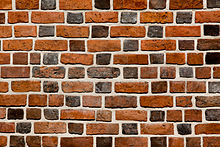




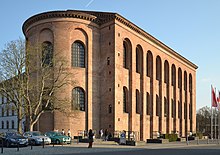

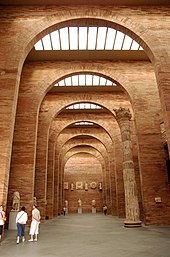
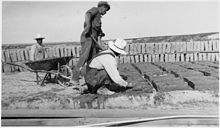


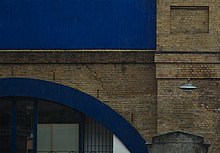






Brick (disambiguation)Flemish bondEnglish bondmasonrymortarbrickworksexpanded clay aggregatebuilding materialsmudbricksbrickworkJetavanaramayaAnuradhapuraSri LankaTell AswadTigrisAnatoliaDiyarbakirÇatalhöyükJerichoSouth AsianMehrgarhIndus ValleyMohenjo-daroHarappaKalibanganGreat Bath at Mohenjo-daroKaalibanganPataliputraKausambiUjjainHanging Gardens of BabylonShebeli TowerChengtoushanDaxi cultureQujialing periodvaultsSongyue PagodaQin Shi Huangditerracotta armyEastern Han dynastyYingzao FashiSong dynastyglazingTiangong KaiwuTimothy BrookMing dynastyRoman brickWalter RitchieAula PalatinaConstantine IMediterraneanAncient GreeksRomansRoman legionsRoman Empirebaths of CaracallaEarly Middle AgesNorthern Europebrick GothicGothic architectureKaliningradEast PrussiaMalbork CastleTeutonic OrderBrick RenaissanceItalian RenaissanceRenaissanceBaroque architectureLübeckSchwerinSchwerin CastleWismarbulk transportrailwaysNational Museum of Roman ArtMérida, SpainRafael MoneoIndustrial RevolutionLondonpatentedBradley & Craven LtdMiddlesexSouth Eastern Railway CompanyFolkestoneNew York Statewrought ironconcreteskyscraperMonadnock BuildingSwiss Federal Institute of TechnologyBuilding Research EstablishmentWatfordMudbrickgraveltree barkembodied energycarbon footprintpegmatitegranitealuminosilicatequartzSilicaAluminaIron oxideMagnesiahydraulicpugmillwaste heatHoffmann kilnNgcoboconveyorswoodlotsscove kilnsWaterloo stationLondon stock bricksalt glazingcolourantsautoclavearrisespost-Sovietfly ash bricksfly ashConcrete masonry unitGuilinyangCompressed earth blockCompressed earth blocks
